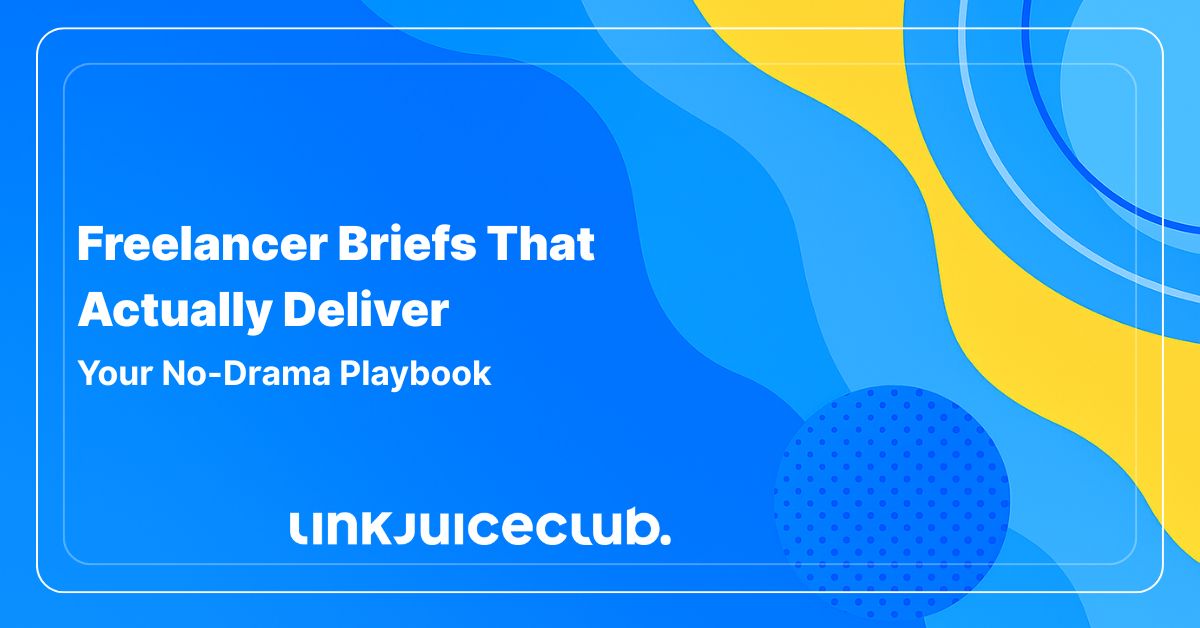
Freelancer Briefs That Actually Deliver: Your No-Drama Playbook
Working with freelancers can unlock serious scale, if your brief does its job. A tight, useful brief protects your brand voice, cuts the back-and-forth, and keeps deadlines and quality on track. A vague one does the opposite.
This playbook shows you how to write briefs that save time, sharpen output, and keep projects moving, whether it’s a thought-leadership blog, a social series, or a product landing page.
Why Your Brief Is The Boss
A brief isn’t admin—it’s the blueprint. Done well, it eliminates guesswork, aligns expectations from day one, and gives your freelancer the confidence to deliver.

What Great Briefs Actually Contain
- Outcome, not vibes: What should this piece achieve, awareness, traffic, leads, signups?
- Audience clarity: Who’s reading/watching and what they care about.
- Voice & tone guardrails: How it should sound (and how it shouldn’t).
- Deliverable specifics: Format, length, assets, and any non-negotiables.
- SEO inputs (if relevant): Primary/secondary keywords, search intent, and internal links.
Keep it crisp. Comprehensive ≠ bloated.
Start With The Win: Goals & Deliverables
If you can’t define success, your freelancer can’t hit it.
Define Success Before You Write
Spell out the job-to-be-done: educate, rank, convert, nurture, demo, or announce. Add KPIs if you have them (e.g., organic clicks, demo requests, CTR).
Spell Out The Asset, Not Just The Topic
“Write about X” invites scope creep. “1,200-word guide + 3 social snippets + header image” removes ambiguity and helps your freelancer plan time and pricing.
Equip Your Freelancer: Context That Cuts Guesswork
Freelancers juggle clients. Give the context that shortcuts learning curves.
Brand Snapshot In 60 Seconds
What you do, for whom, and why you’re different. Keep it short, clear, and current.
Topic, Campaign, And Differentiation
Explain what this piece supports (product, feature, campaign), what angles matter, and how you want to stand apart from competitors.
Guides, Docs, And Non-Negotiables
Link your tone/voice guide, messaging pillars, fact sheets, and style preferences (e.g., “no Oxford comma,” “US spelling,” “avoid industry jargon X”).
Write For Someone: Audience & Voice
Great content speaks to a person, not a persona slide.
Who They Are, What They Need
Role, seniority, industry, pains, and desired outcomes. Name the stage (awareness/consideration/decision) so depth and CTA match intent.
Tone Dial: From Boardroom To Barstool
Set the dial (e.g., “confident, practical, zero fluff”). Add 2–3 example lines that feel “on voice,” and one that doesn’t—so boundaries are obvious.
Timeboxing The Work: Deadlines That Drive Quality
Rushed work costs more later. Set timelines that protect quality and momentum.
Milestones Beat Mysteries
Break delivery into checkpoints (outline → draft → revisions → final). You’ll catch misalignment early and avoid full rewrites at the end.
A Simple, Realistic Timeline
- Outline due: Feb 2
- Draft due: Feb 5
- Feedback returned: Feb 8
- Final due: Feb 12
Adjust to your cadence, but commit—and respond fast at each step.
Show, Don’t Tell: References That Align Taste
Taste is hard to brief in abstract. Examples make it concrete.
What To Share
- 1–2 links you love (and why)
- 1 link you don’t (and why)
- Notes on structure you prefer (e.g., punchy intro, scannable H2s, strong CTA mid-piece)
How To Comment On Examples
Call out specifics: “This intro stakes a claim in 2 lines,” “Great subhead rhythm,” “Charts clarify the point—let’s include one where we define X.”
Collaborate Like A Pro: Habits That Speed Delivery
The brief starts the job; collaboration finishes it.
Feedback That Fixes, Not Flattens
Praise what works, be specific about changes, and explain why. “Tighter,” “more punchy,” and “add value” are not actionable.
Keep The Line Open
Invite questions before writing begins. A 10-minute alignment saves a 10-hour rewrite.
Be Reachable For Quick Clarifications
Fast answers keep momentum. Slow replies create gaps, missed context, and deadline risk.
Wrap-Up: Clarity In, Quality Out
A sharp brief is leverage. It protects your voice, accelerates delivery, and keeps every piece aligned with strategy. Invest up front—define the win, name the audience, set the tone, map the milestones, and show examples. Your freelancers will thank you with work that lands, on time, on brand.





